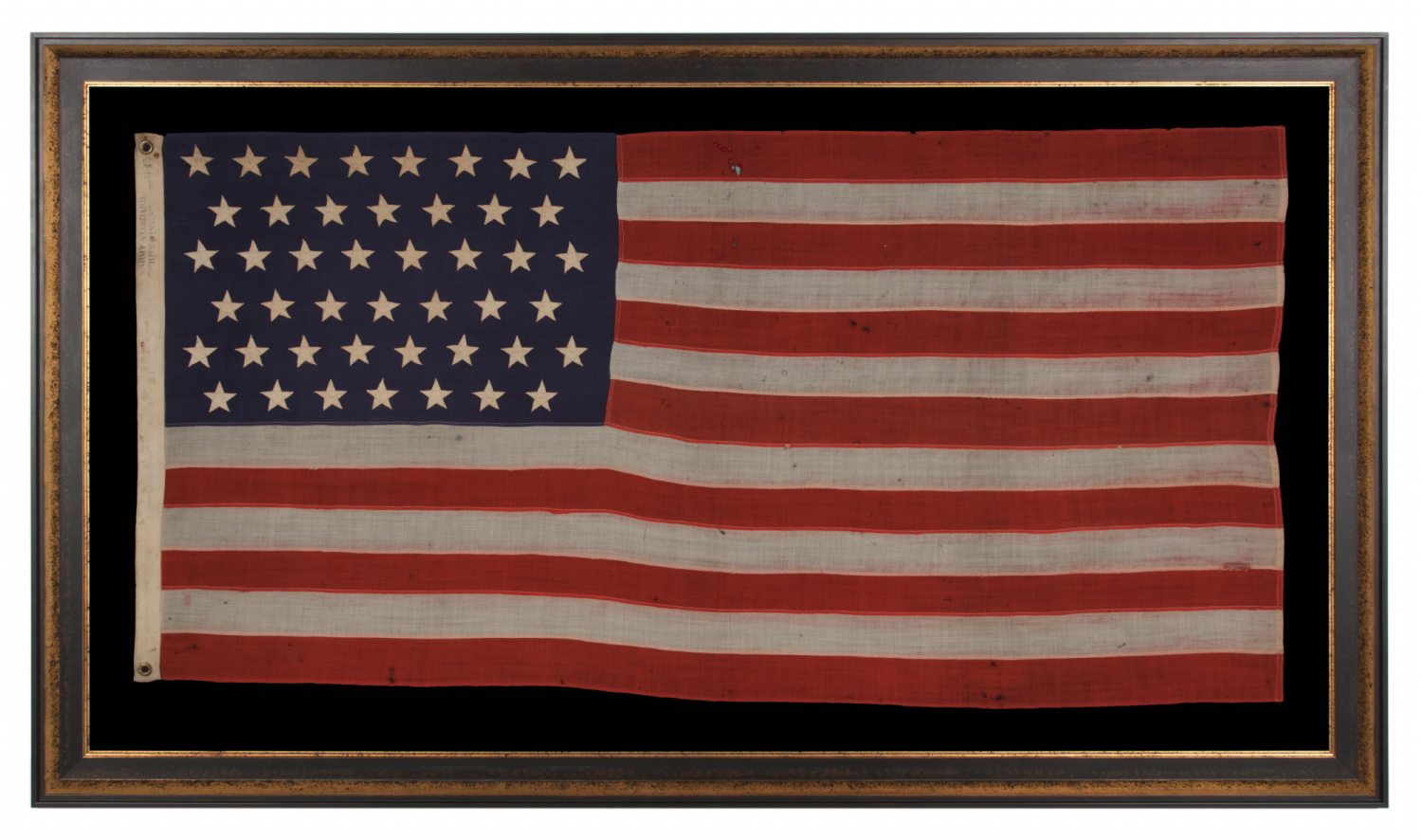


| 45 STAR ANTIQUE AMERICAN FLAG, MARKED "U.S. ARMY STANDARD BUNTING,” SPANISH-AMERICAN WAR ERA, REFLECTS THE ADDITION OF UTAH AS THE 45TH STATE, 1896-1907 |
|
| Web ID: | 45j-985 |
| Available: | In Stock |
| Frame Size (H x L): | Approx. 47.5" x 82" |
| Flag Size (H x L): | 35.5" x 70" |
| Description: | |
| 45 star American national flag, in a relatively small and desirable scale for this period, with a traditional 8-7-8-7-8-7 arrangement of stars in staggered rows and an interesting stencil along the hoist. Utah became the 45th state on January 4th, 1896. It had been attempting to gain statehood for many years, but remained a territory, primarily due to the fact that the Mormon Church and Utah authorities continued to be openly tolerant of polygamy. In 1890, Mormon Church President Wilford Woodruff published a manifesto that denounced the contract of “any marriages forbidden by the law of the land”. This gave way to Utah’s 1896 acceptance. Although this technically remained the official star count until July 3rd, 1908, the 45 star flag was generally used from that year until 1907, when Oklahoma joined the Union. Due to the Spanish-American War (1898) and Teddy Roosevelt’s famous world tour of the “White Fleet” (launched in 1907), this was an extremely patriotic period. The stars of the flag are made of cotton and are oriented throughout with one point facing upward. These were double-appliquéd (applied to both sides) with a zigzag machine stitch. The striped field and canton are made of wool bunting that has been pieced and joined by machine, with a lineal stitch. There is a twill-woven, sailcloth binding along the hoist, with two brass grommets, along which the following appears in an inked, black stencil: “U.S. Army Standard Bunting,” followed by “6 ft,” to denote the flag’s length on the fly. This in no way meant that this was a U.S. Army flag. It was a brand name, used by the maker, to indicate the grade of wool bunting used to produce it. It may be that this particular variety was at some point used to fulfill United States Army contracts. While the scale may seem large to the casual observer, unfamiliar with 19th century examples, it is important to understand that most flags with pieced-and-sewn construction, made prior to 1890, measured 7-8 feet larger on the fly. A 6-footer was considered small. A change was starting to take place during the last decade of the 19th century, one flag makers began to produce 3- and 4-foot long examples in quantity for the first time. These seldom ever displayed the full star count of the period, but rather a complement of 13 stars, to reflect the 13 original colonies. Sewn flags, in the full star count, were almost never made in those sizes. Presidents who served during this period were Democrat Grover Cleveland, in his second, non-consecutive term, the two terms of Republican William McKinley, the second of which was cut short by his assassination (shot 09/06/1901, passed 09/14/1901), and the two terms of Theodore Roosevelt, the first of these attained by ascension. Mounting: The flag was mounted and framed within our own conservation department, which is led by expert staff. We take great care in the mounting and preservation of flags and have framed thousands of examples. The flag has been hand sewn throughout, on the reverse, to 100% silk organza throughout. It was then hand-stitched to a background of 100% cotton twill, black in color, that was washed and treated for colorfastness. The mount was then placed in a black-painted, hand-gilded and distressed Italian molding. The glazing is U.V. protective acrylic (Plexiglas). Feel free to contact us for more details. Condition: There is extremely minor mothing in the blue canton, and minor mothing throughout the striped field. There is a small, lateral tear on the lower edge of the 5th red stripe, near the fly end, accompanied by excessive wear with some fabric loss in the seam directly below it. There is minor to modest soiling in the canton, mostly towards the top edge, as well as along the binding, where there is also a series of tiny tackles with extremely minor to minor associated rust stains. There are extremely tiny splatters of grey paint in the 1st and second red stripes, accompanied by a couple of modest sized spots of the same, and a minor to modest spot of light green in the white stripe below the canton. There is very minor bleeding of the red dye in approximately the first three quarters of the flag’s length, with modest to moderate of the same as it progresses through the last quarter, toward the fly end. There is minor staining and The White Stripes, more significant in the region beyond the canton, towards the fly end. There is a small spot of red dye transfer near the hoist end of the 6th white stripe. Many of my clients prefer early flags to show their age and history of use. |
|
| Video: | |
| Collector Level: | Intermediate-Level Collectors and Special Gifts |
| Flag Type: | Sewn flag |
| Star Count: | 45 |
| Earliest Date of Origin: | 1896 |
| Latest Date of Origin: | 1907 |
| State/Affiliation: | Utah |
| War Association: | 1898 Spanish American War |
| Price: | Please call (717) 676-0545 or (717) 502-1281 |
| E-mail: | info@jeffbridgman.com |
 |
|